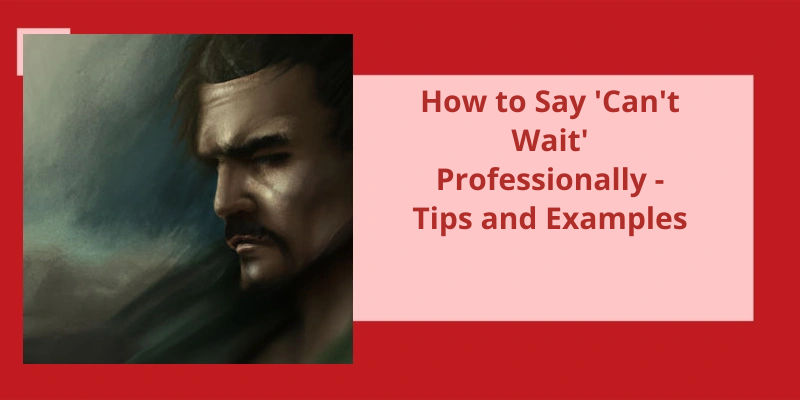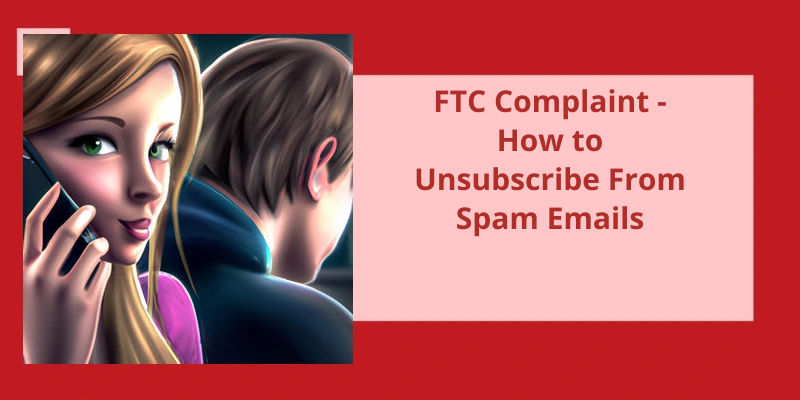As professionals, it’s important to convey our excitement and anticipation in a manner that’s polished and appropriate for the context. While expressions like "can't wait" may feel natural in casual conversation, they may come across as unprofessional in certain settings. Luckily, there are a variety of ways to express anticipation and eagerness with more finesse. Synonyms like "looking forward to" or "awaiting the opportunity to" can be used to convey excitement in a more polished way. By using appropriate language, we can communicate our enthusiasm without sacrificing professionalism. So, whether it's waiting for a big project to be completed or anticipating an upcoming meeting, it's essential to choose our words carefully to reflect the appropriate tone in professional settings.
How Do You Say Take Your Time Professionally?
When it comes to professional communication, it’s important to choose your words carefully. Using the right language can make all the difference in how your message is received. When you want to convey a sense of patience or lack of urgency, there are several phrases you can use. Instead of saying “take your time,” you might try saying “whenever you can.”. This phrase suggests that there’s no strict deadline and that the other person can work at their own pace.
Another way to convey a similar message is to say, “It’s not terribly urgent.”. This phrase acknowledges that there’s a level of importance, but it also suggests that there’s flexibility in terms of timing. By using the word “terribly,” youre indicating that the matter can wait, but it’s not completely unimportant. This can be a good way to strike a balance between expressing a sense of urgency and giving the other person the space they need.
If you truly have no deadlines at all, you might say something like “No rush.”. This phrase is clear and concise, and it leaves no doubt that the other person can take their time. It’s a good choice when you want to convey a sense of calm and relaxation, and it can help put the other person at ease.
Another approach is to use a longer phrase, such as “Theres no need to hurry.”. This phrase is more formal than some of the others, and it can be a good choice when youre communicating with someone you don’t know very well. It conveys a sense of professionalism and courtesy, and it also suggests that youre willing to be flexible and accommodating.
Ultimately, the key is to choose words that are appropriate for the situation and the person youre communicating with. By taking the other persons needs and preferences into account, you can create a message that’s clear, concise, and effective. Whether you say “whenever you can,” “no rush,” or something else altogether, make sure youre using language that conveys the right message and tone. That way, youll be more likely to get the response youre looking for.
When you need someone to wait, it’s important to be polite and use the right words. There are several ways to express the idea of waiting, including “bide one’s time,” “hang fire,” and “cool one’s heels.” On the other hand, you can describe the opposite of waiting with words like “leave” or “discontinue.” It’s essential to consider the context and tone of your message, so you convey your message respectfully.
What Is a Polite Way of Saying Wait?
When it comes to communication, choosing the right words can make a big difference in how the message is received. In situations where you need to ask someone to wait, it’s important to do so politely and respectfully. Using words such as “please” and “excuse me” can help convey your message in a way that shows consideration for the other persons time and feelings.
There are a variety of words and phrases that can be used to express the idea of waiting. Some synonyms for “wait” include “stand by,” “bide ones time,” and “hold on.”. These words suggest a temporary delay or pause, often with the expectation of something happening in the near future. On the other hand, words like “halt,” “cease,” and “discontinue” indicate a more permanent stop, suggesting that the activity in question won’t be resumed any time soon.
For example, “hang fire,” “cool ones heels,” and “twiddle ones thumbs” all suggest a sense of inactivity or idle waiting. These phrases can be used in a humorous or lighthearted way, but can also be seen as somewhat dismissive or impatient, depending on the context.
Some polite phrases include “please hold on a moment,” “if you wouldnt mind waiting a bit longer,” and “I appreciate your patience.”. These phrases express gratitude for the other persons willingness to wait, and acknowledge their time and effort. It’s also important to communicate clearly about how long the wait is expected to be, as this can help manage expectations and prevent frustration.
For example, “lets proceed,” “lets move on,” and “if we could get started now” all suggest a desire to take action or make progress. These phrases can be especially useful in professional settings, where efficiency and productivity are often valued.
Overall, choosing the right words to express the idea of waiting is an important aspect of effective communication. Whether you’re asking someone to wait, or indicating a desire to move forward, using the right tone and phrasing can help ensure that your message is received in the way you intend. By approaching these situations with consideration and respect, you can build stronger relationships and avoid potential misunderstandings or conflicts.
How to Politely Ask Someone to Hurry Up After They’ve Been Waiting for a While
- Excuse me, but do you mind hurrying up a bit?
- Would it be possible for you to speed things up a little?
- Sorry to sound impatient, but could you move a bit faster?
- Is there any way you could try to hurry up a little bit?
- Could you please try to pick up the pace a bit?
- I don’t mean to rush you, but could you try to get things moving a little faster?
- Would it be alright if I asked you to try and speed things up a bit?
- Is there any chance you could try to move a little more quickly?
- I hate to be a bother, but could you try to hurry up just a bit?
- Do you think it would be possible for you to move faster?
When it comes to finding alternatives for the phrase “wait for it,” there are many options to choose from. From “assume” and “await” to “forecast” and “prepare for,” each synonym offers a unique way to build anticipation and intrigue in your writing. By exploring a range of possibilities, you can find the perfect way to keep your readers engaged and interested, without relying on repetitive language or predictable phrases. So, let’s take a closer look at some of the top synonyms for “wait for it,” and discover how they can add depth and excitement to your writing.
What Can I Say Instead of Wait for It?
Are you tired of using the same old phrase “wait for it” in your conversations, presentations or speeches? It’s time to switch it up with some fresh and exciting alternatives. There are plenty of synonymous phrases that can add more spice to your sentences and keep your audience engaged.
One of the most common and simple alternatives to “wait for it” is “wait on.”. This phrase is easily interchangeable with “wait for it” and is often used when referring to someone serving or assisting another person in some way. For example, “Ill wait on the customer while you grab their order.”
If you want to add a touch of elegance and sophistication to your vocabulary, you can use “await” instead of “wait for it.”. For instance, “I await the day we can all gather again.”
Another word you can use instead of “wait for it” is “forecast.”. This term is especially useful when you want to talk about future events and predict their outcomes. For example, “I forecast that we will see more sunny days in the coming weeks.”
Similarly, “foresee” can be used to express your expectations or predictions about something thats yet to happen. It’s also a great way to show your foresight and insight into a situation. For instance, “I foresee that we will face many challenges during this project.”
If you want to be proactive and prepared for whatever comes your way, you can use “prepare for” instead of “wait for it.”. This phrase suggests that youre taking action to get ready for an event or situation. For example, “Lets prepare for the worst-case scenario just in case.”
Lastly, “conjecture” is another word you can use instead of “wait for it” when you want to express your opinion or speculation about something. This term implies that youre making an informed guess based on the information available to you. For instance, “I conjecture that she’ll be the next CEO of the company.”
Source: 82 Synonyms & Antonyms for WAIT FOR – Thesaurus.com
When waiting for a response in a professional setting, it can be difficult to express your eagerness without sounding too casual or impatient. However, using the right tone and language can help you convey your message in a way that’s both polite and business-friendly. Here are some alternatives to consider when saying “I’ll wait for it” in a professional context.
How Do You Professionally Say I Will Wait for It?
When communicating in a professional setting, it’s important to maintain a level of courtesy and respect. This extends to the language that we use, particularly when requesting information or follow-up from colleagues or clients. One common phrase that’s often used in these scenarios is “I’ll wait for it.”. However, this phrase may not always be appropriate in a business context, as it can come across as unprofessional or impatient.
Fortunately, there are a number of more business-friendly alternatives that can be used instead. For example, instead of saying “I’ll wait for it,” you could say “Im eagerly awaiting your response.”. This conveys a similar sense of urgency, while also expressing enthusiasm and positivity.
Another alternative is to use a more formal tone, by saying “Your prompt response would be appreciated.”. This acknowledges the importance of the information being requested, while also conveying a sense of professionalism and respect for the recipients time.
Regardless of the language used, it’s always a good idea to express gratitude and appreciation for any response received. This can be done by saying something like “Thank you for your timely response.”. Not only does this show respect for the other persons time and effort, it also fosters a sense of goodwill and positive working relationships.
In some cases, it may be appropriate to offer additional support or assistance to help expedite the response. For example, saying “Please let me know if theres anything I can do to assist in providing the information you need” can be a helpful way to show that you understand the importance of the request, while also demonstrating a willingness to help.
Ultimately, the key to communicating effectively in a professional context is to strike a balance between clarity, courtesy, and professionalism. By using language that’s respectful, concise, and appropriate for the situation at hand, you can build stronger relationships and achieve better outcomes in your business communications.
How to Express Urgency Without Being Pushy or Demanding
- Use phrases like “immediately” or “as soon as possible”
- Highlight the importance or impact of the task at hand
- Provide a deadline or time constraint
- Show understanding and empathy towards the recipient’s situation
- Use visual aids like bold or italicized text to emphasize urgency, but use sparingly
- Offer assistance or resources to help the recipient complete the task more efficiently
- Be direct and concise in your communication
- Acknowledge the recipient’s efforts and contributions towards the task, but reiterate the urgency of completing it
- Provide clear and specific instructions to avoid confusion or delays
- Use polite and professional language to avoid coming across as demanding or aggressive
Conclusion
In conclusion, effective communication in professional settings relies heavily on using the right words and phrases. Expressing excitement or anticipation about an upcoming event or project requires a certain level of sophistication and poise. It’s important to master the art of communicating professionally, and using appropriate synonyms for "can't wait" is just one small step in the right direction. By adopting these phrases and integrating them into one's vocabulary, one can effectively convey their anticipation and excitement in a polished way.






